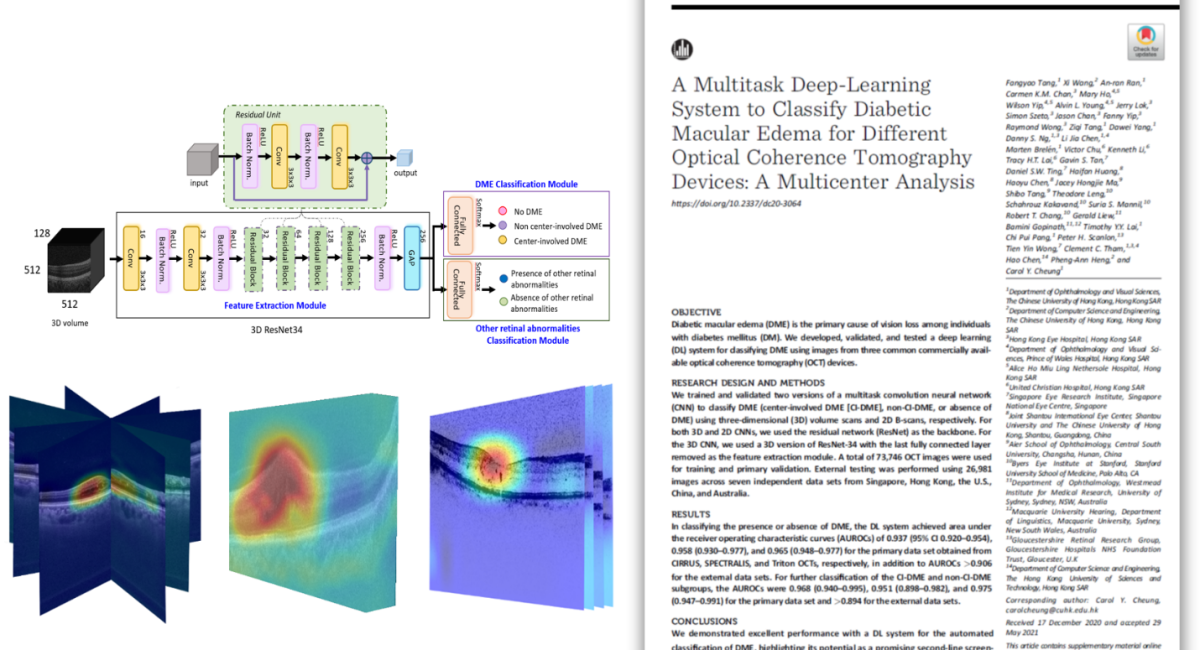Dr Carol YL CHEUNG and her team published a research article in Diabetes Care, entitled ″A Multitask Deep-Learning System to Classify Diabetic Macular Edema for Different Optical Coherence Tomography Devices: A Multicenter Analysis″.
Diabetic macular edema (DME) is the primary cause of vision loss among individuals with diabetes mellitus. Accurate identification of DME and timely treatment can prevent vision loss. Optical coherence tomography (OCT) is widely used as a tool to detect and manage DME. Nevertheless, current OCT classification does not provide information regarding specific eye diseases. Interpretation of OCT data for DME assessment still requires expertise from ophthalmologists, particular from retinal specialists. This is prohibitively cost-ineffective, and also practically impossible under present circumstances due to the lack of experienced expert manpower to perform screening.
In this study, Dr Cheung and her team developed and validated an artificial intelligence (AI) deep-learning algorithm using OCT images for the detection of DME with further classification into center-involved DME versus noncenter-involved DME. The deep-learning system has further been tested in other datasets from our local (Hong Kong Eye Hospital, Prince of Wales Hospital, Alice Ho Miu Ling Nethersole Hospital, United Christian Hospital) and international (Singapore Eye Research Institute, Singapore; Joint Shantou International Eye Center, Shantou University and the Chinese University of Hong Kong, China; Aier School of Ophthalmology, China; Stanford University School of Medicine, USA; University of Sydney, Australia; Macquarie University, Australia and Gloucestershire Hospitals NHS Foundation Trust, UK) collaborators. The system showed excellent performance across diverse study populations in different settings. Findings from this study extends the promise of incorporating OCT into current retinal fundus photography-based diabetic retinopathy screening programs as a second-line screening tool, allowing for the efficient and reliable detection of DME, which may lead to reductions in over-referrals and increased clinical use of deep-learning systems.
Congratulations to Dr Cheung and the team!
Reference:
Tang F, Wang X, Ran AR, Chan CKM, Ho M, Yip W, Young AL, Lok J, Szeto S, Chan J, Yip F, Wong R, Tang Z, Yang D, Ng DS, Chen LJ, Brelén M, Chu V, Li K, Lai THT, Tan GS, Ting DSW, Huang H, Chen H, Ma JH, Tang S, Leng T, Kakavand S, Mannil SS, Chang RT, Liew G, Gopinath B, Lai TYY, Pang CP, Scanlon PH, Wong TY, Tham CC, Chen H, Heng PA, Cheung CY (corresponding author). A Multitask Deep-Learning System to Classify Diabetic Macular Edema for Different Optical Coherence Tomography Devices: A Multicenter Analysis. Diabetes Care. (In press 2021)

